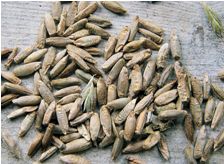Reproduction
Rye, like all grasses, has two methods of reproduction. The
first method is asexual and the second is sexual. Asexually,
they reproduce with a growth point in the roots called a
shoot, or tiller. It branches off from the original plan t and forms
an exact copy of the original parent. The other way that rye can
reproduce is by sexual reproduction. They have special flowers
that form called spikelets. These spikelets produce spores which
are blown by the wind and pollinate other spikelets. Seeds then
form and if the natural process is allowed to proceed, drop to
the ground.
t and forms
an exact copy of the original parent. The other way that rye can
reproduce is by sexual reproduction. They have special flowers
that form called spikelets. These spikelets produce spores which
are blown by the wind and pollinate other spikelets. Seeds then
form and if the natural process is allowed to proceed, drop to
the ground.
There are many advantages and disadvantages of sexual and asexual reproduction. The main advantage of asex is that it is much faster and more efficient than sexual reproduction. Many copies can be formed in a short period of time, allowing the rye to overwhelm competition. The biggest advantage of sexual reproduction is that it allows for genetic diversity. Genetic diversity is a huge advantage when an organism's habitat is in a period of flux. Diversity lets the organism change with the rest of nature.
Continue on to Interactions
This picture came from the Wikimedia Commons
